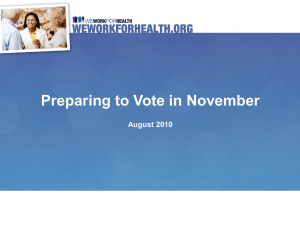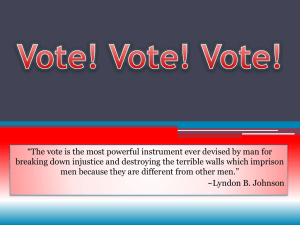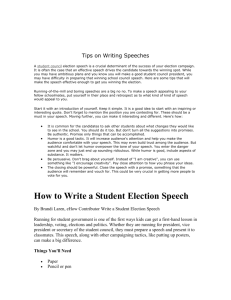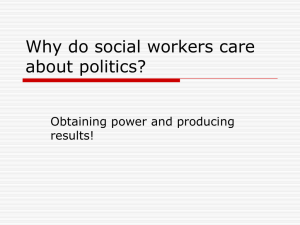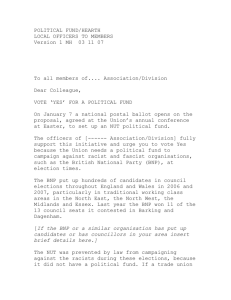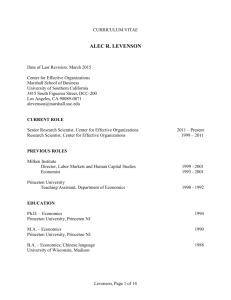Lesson ideas for teachers – free
advertisement
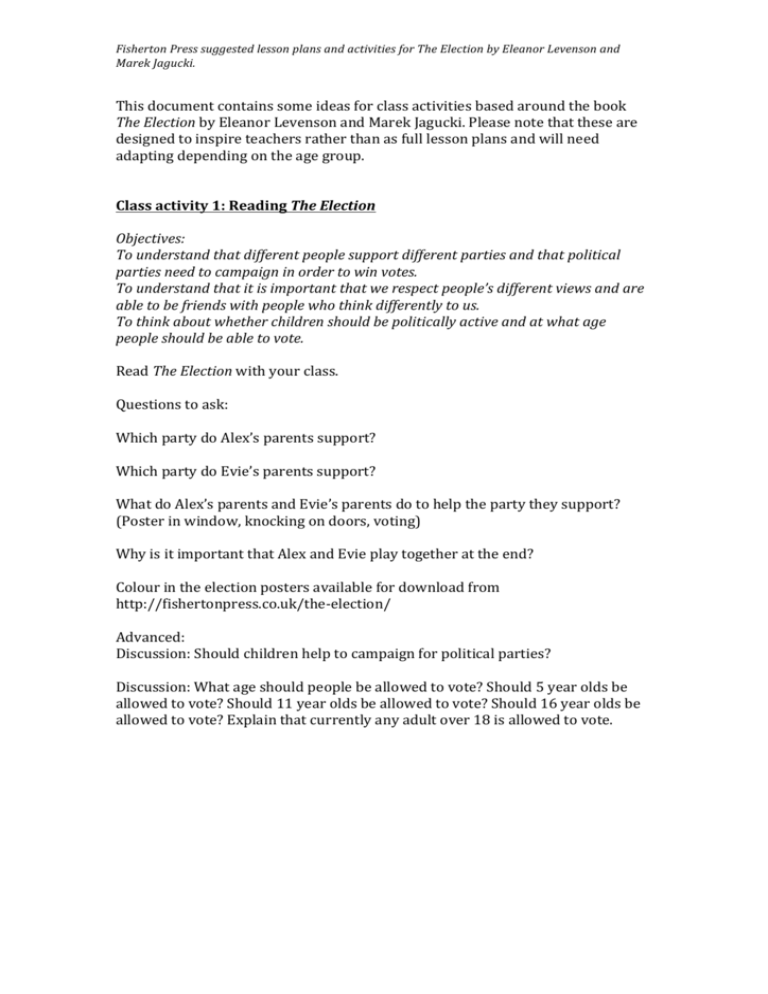
Fisherton Press suggested lesson plans and activities for The Election by Eleanor Levenson and Marek Jagucki. This document contains some ideas for class activities based around the book The Election by Eleanor Levenson and Marek Jagucki. Please note that these are designed to inspire teachers rather than as full lesson plans and will need adapting depending on the age group. Class activity 1: Reading The Election Objectives: To understand that different people support different parties and that political parties need to campaign in order to win votes. To understand that it is important that we respect people’s different views and are able to be friends with people who think differently to us. To think about whether children should be politically active and at what age people should be able to vote. Read The Election with your class. Questions to ask: Which party do Alex’s parents support? Which party do Evie’s parents support? What do Alex’s parents and Evie’s parents do to help the party they support? (Poster in window, knocking on doors, voting) Why is it important that Alex and Evie play together at the end? Colour in the election posters available for download from http://fishertonpress.co.uk/the-­‐election/ Advanced: Discussion: Should children help to campaign for political parties? Discussion: What age should people be allowed to vote? Should 5 year olds be allowed to vote? Should 11 year olds be allowed to vote? Should 16 year olds be allowed to vote? Explain that currently any adult over 18 is allowed to vote. Fisherton Press suggested lesson plans and activities for The Election by Eleanor Levenson and Marek Jagucki. Class activity 2: How elections work Objectives: To show how first past the post elections work. To understand how to cast a vote. Hold a class election on the following question: What is your favourite fruit? Answers: Apple Banana Orange Hand out the ballot paper (found in Appendix 2 at end of this document). There should be one ballot paper per person. Explain to students that they can mark which of these options is their favourite using an X. Explain that any voting papers that have more than one X, or any other markings, will be ‘spoiled’ and not counted. It is suggested that the teacher deliberately spoils their voting slip so this can be shown as an example later in the lesson. Ask the students to make up their own mind which fruit to vote for and to fill out their form alone. Explain the reasons for doing this – that the vote will only show what people really think if they are allowed to decide by themselves and that you vote alone so that no one can influence you at the moment you cast your vote (make your decision). Together count the completed voting slips and the number of people who received one. These need to be the same for the vote to be valid. Count how many votes there are for each fruit. Do not count any spoiled voting slips. The fruit with the most votes is the winner. Explain that this system of voting where the thing (person/party) that has the most votes is the winner is called First Past the Post. Explain that there are other ways of voting where you can choose the order you like things in, or make more than one choice, but that you are not covering that today. Fisherton Press suggested lesson plans and activities for The Election by Eleanor Levenson and Marek Jagucki. Explain that in elections adults get to choose between the people they want to win the vote. Sometimes these people are independent (working alone), and sometimes they work with other people who believe the same things, called a party. Advanced: Before you hold the vote, split the class into three groups – The Apple Party, The Banana Party, The Orange Party. Ask each group to come up with three reasons why their fruit is best. Each group should present these reasons to the rest of the class before the vote. Fisherton Press suggested lesson plans and activities for The Election by Eleanor Levenson and Marek Jagucki. Class activity 3: Ways of influencing Objectives: To think about different ways of influencing people and the advantages and disadvantages of each of these. To understand the need for posters to attract attention. (Advanced) To understand the difference between positive and negative messages. In The Election Alex’s parents support the stripy party and Evie’s parents support the spotty party. What are the ways you can spot the stripy party and the spotty party trying to get attention? Answers: Posters Leaflets Knocking on doors Stickers Loudspeaker cars Television appearances What do you think the advantages and disadvantages of each of these might be? Some suggestions include: Talk to people on a personal level and hear what they have to say People get to hear your personal views Leads to discussion Talk to lots of people at once Seems impersonal Only reaches a small amount of people Remind people that you exist Can give a lot of information Can look at it several times Can’t go into detail about what you believe Relies on people reading the information Takes a lot of time Suggested activity: Basic: Colour in the election posters available for download from http://fishertonpress.co.uk/the-­‐election/ Advanced: Design your own poster for the stripy or spotty party, or a completely new party. It needs to: Fisherton Press suggested lesson plans and activities for The Election by Eleanor Levenson and Marek Jagucki. -­‐ -­‐ attract attention be clear which party it is for It might also: -­‐ tell you a bit what that party believes Further discussion: Sometimes posters try to be positive (say good things) about the issue, person or party they want you to vote for. Sometimes posters try to be negative (say bad things) about the issue, person or party they want you to vote for. Look at these two examples of famous political posters. These can be found online using the following search terms or can be found in Appendix 1 at the end of this document. Barack Obama, Shepard Fairey, Hope New Labour New Danger, Tony Blair One works by being positive about the person the poster is supporting. One works by being negative about the person the poster is not supporting. Advanced activity: Split into four groups. One group should design a poster for the Stripy Party that is positive about the Stripy Party. One group should design a poster for the Stripy Party that is negative about the Spotty Party. One group should design a poster for the Spotty Party that is positive about the Spotty Party. One group should design a poster for the Spotty Party that is negative about the Stripy Party. Advanced discussion: What are disadvantages of negative posters? Suggested answers: It can make you look bad if you are mean about other people If you focus on the other party no one knows what you actually believe Fisherton Press suggested lesson plans and activities for The Election by Eleanor Levenson and Marek Jagucki. You are giving publicity to the other party Class activity 4: Policies Objectives: To show that different parties have different policies (ie things they say they will do if they win the election). To have the confidence to make a speech. To understand how to persuade people to vote for them. To understand the ‘first past the post’ voting system Split the class into small groups of five or six pupils. Give each group a colour to be their party eg The Purple Party, The Yellow Party, The Pink Party etc Explain what a policy is – something the party says they will do if they are in charge. Give each group the following list of policies – they must choose one from each group. These are repeated in Appendix 3 for ease of copying: Choose one from this group: All children must do an hour’s homework every night Children cannot watch television during the week You cannot own a mobile phone until you are 16 Choose one from this group: A free holiday each year for every family Every child gets a free computer Children will get a pound for every week they have full attendance at school Choose one from this group: The summer holiday from school will be cut to three weeks Children will be able to drive from aged 12 Every road will have a cycle path When each party has chosen their policies ask them to design posters to explain these policies. They should remember to use their party colour so their posters are identifiable. Together they should write a speech explaining their three policies and a reason for each one. Eg: Children will not be allowed to watch television during the week so they can focus on their homework Every road will have a cycle path so children can cycle to school safely Each group should choose someone to give their speech to the rest of the class. Fisherton Press suggested lesson plans and activities for The Election by Eleanor Levenson and Marek Jagucki. After all speeches the class should hold a vote to see which party wins. The children should not be allowed to vote for their own party to ensure that they don’t all vote for themselves. (If more than one class is doing this activity they could present to the other class and the other class could vote.) A ballot paper than can be adapted is at the end of this document as Appendix 4. Hand out the ballot paper. There should be one ballot paper per person. Explain to students that they can mark which of these options is their favourite using an X. Explain that any voting papers that have more than one X, or any other markings, will be ‘spoiled’ and not counted. It is suggested that the teacher deliberately spoils their voting slip so this can be shown as an example later in the lesson. Ask the students to make up their own mind which Party to vote for and to fill out their form alone. Explain the reasons for doing this – that the vote will only show what people really think if they are allowed to decide by themselves and that you vote alone so that no one can influence you at the moment you cast your vote (make your decision). Together count the completed voting slips and the number of people who received one. These need to be the same for the vote to be valid. Count how many votes there are for each fruit. Do not count any spoiled voting slips. The Party with the most votes is the winner. Explain that this system of voting where the thing (person/party) that has the most votes is the winner is called First Past the Post. Fisherton Press suggested lesson plans and activities for The Election by Eleanor Levenson and Marek Jagucki. Appendix 1 Ballot Paper – Favourite Fruit Write an X next to your favourite fruit Name of fruit APPLE BANANA ORANGE Fisherton Press suggested lesson plans and activities for The Election by Eleanor Levenson and Marek Jagucki. Appendix 2 Fisherton Press suggested lesson plans and activities for The Election by Eleanor Levenson and Marek Jagucki. Appendix 3 Policies Choose one from this group: All children must do an hour’s homework every night Children cannot watch television during the week You cannot own a mobile phone until you are 16 Choose one from this group: A free holiday each year for every family Every child gets a free computer Children will get a pound for every week they have full attendance at school Choose one from this group: The summer holiday from school will be cut to three weeks Children will be able to drive from aged 12 Every road will have a cycle path Fisherton Press suggested lesson plans and activities for The Election by Eleanor Levenson and Marek Jagucki. Appendix 4 Ballot Paper – Colour Parties Write an X next to the party you want to vote for Colour



